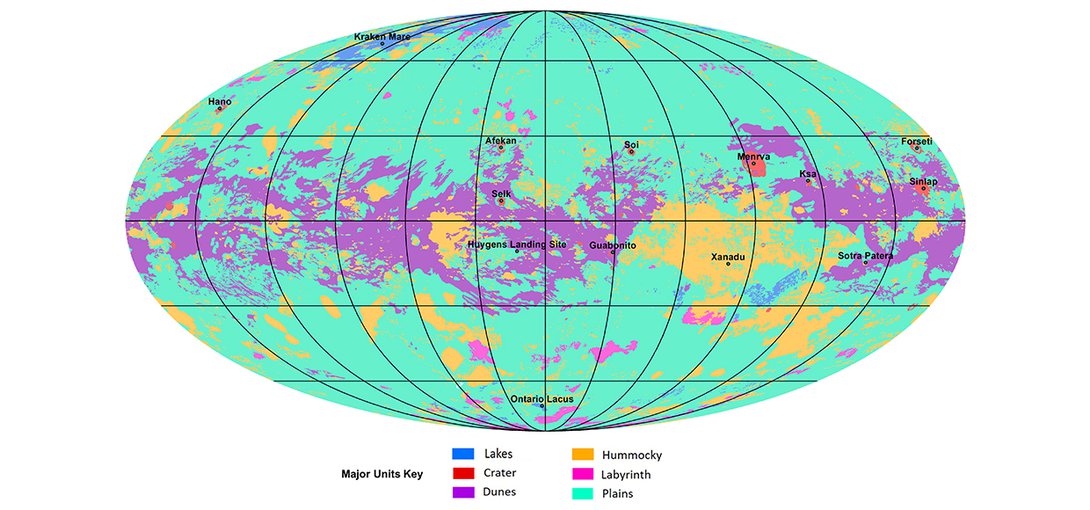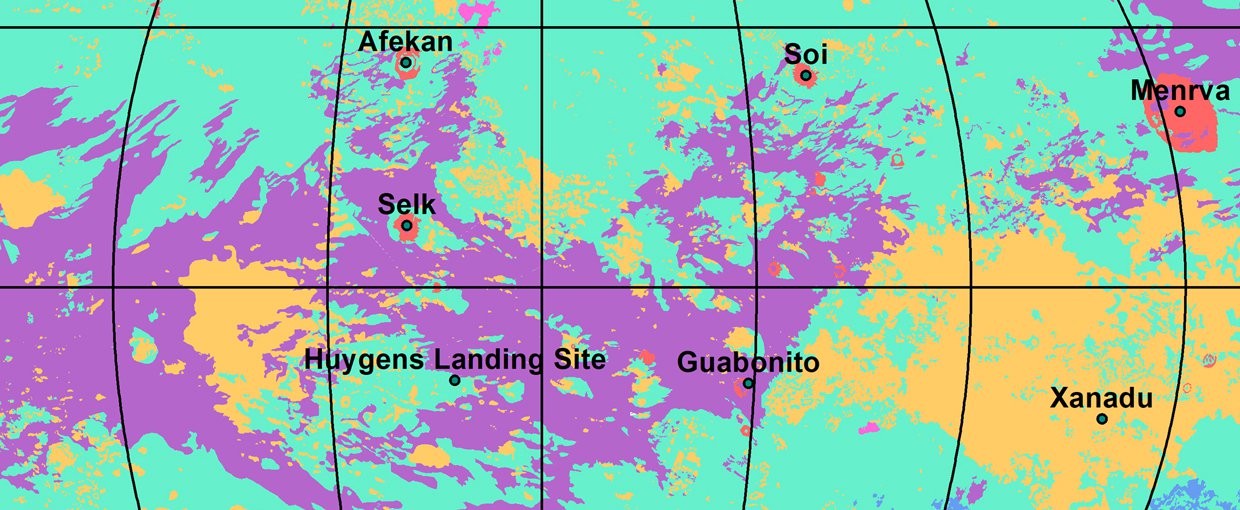
A new study supported in part by the NASA Astrobiology Program has provided a global geomorphological map of Saturn’s moon Titan based on data from the Cassini spacecraft. The global map is at 1:20,000,000 scale and is based on the identification of six major geological units including lakes, hummocky terrain, craters, labyrinth terrain, plains, and dunes.
Titan is currently a primary target for astrobiology research in our solar system. The surface of the moon is shaped by an active methane-based hydrological cycle, with features reminiscent of the Earth. Even though there are stark differences between Titan and the Earth in terms of temperature, gravity, and materials, the moon can provide an opportunity for comparative planetology that allows scientists to better understand geological processes on our own planet.

The first global geologic map of Saturn's largest moon, Titan, is based on radar and visible and infrared images from NASA's Cassini mission, which orbited Saturn from 2004 to 2017.Image credit: NASA/JPL-Caltech/ASU.
When the Cassini spacecraft reached Titan, the mission was able to peer through the moon’s thick, hazy atmosphere and identify geological features that were previously hidden from view. Now, a team of researchers has used Cassini data to create a global map that helps to put these features in context. The team defined six major geological units and mapped them using data from Cassini’s synthetic aperture radar (SAR). The researchers then correlated SAR with other datasets to fill in regions where SAR data wasn’t available. This included data from the Imaging Science Subsystem (ISS) and the Visible and Infrared Mapping Spectrometer (VIMS).
Cassini data has previously shown that Titan is rich in organic material in the form of hydrocarbons that are found at the surface. Hydrocarbon material is transported and deposited around the moon by processes like erosion and can be found covering much of Titan’s surface, including the vast regions of plains and dunes in the recently generated map. The plains of Titan are estimated to cover up to 65% of the total global area.
The new map of Titan highlights relationships between the major geological units, allowing researchers to better understand the processes that have shaped Titan’s surface and how the landscape of has evolved over time. The map indicates that Titan is dominated by sedimentary or depositional processes, ultimately resulting in the large regions of dunes and plains. Variations can also be seen based on latitude, with dune regions near the equator, plains at the mid-latitudes, and lakes and labyrinth terrains at the poles.
The geomorphological map of Titan is a step toward a more thorough understanding of the moon’s surface, which is essential in the development of new missions to the Saturn system relevant to astrobiology. NASA’s Dragonfly mission will be the next to visit Titan and will sample and examine sites around the moon’s surface. Dragonfly is currently being developed to launch in 2026 and will arrive at Titan in 2034.
The study, “A global geomorphologic map of Saturn’s moon Titan,” was published in the journal Nature Astronomy. The work was supported in part through the NASA Astrobiology Institute (NAI) element of the NASA Astrobiology Program. This research is a critical part of NASA’s work to understand the Universe, advance human exploration, and inspire the next generation. As NASA’s Artemis program moves forward with human exploration of the Moon, the search for life on other worlds remains a top priority for the agency.
Additional Resources:
A whole new world: astronomers draw first global map of Titan (Nature)
NASA Announces Astrobiology Mission to Titan (Many Worlds)
NASA Selects Flying Mission to Study Titan for Origins, Signs of Life (NASA)
